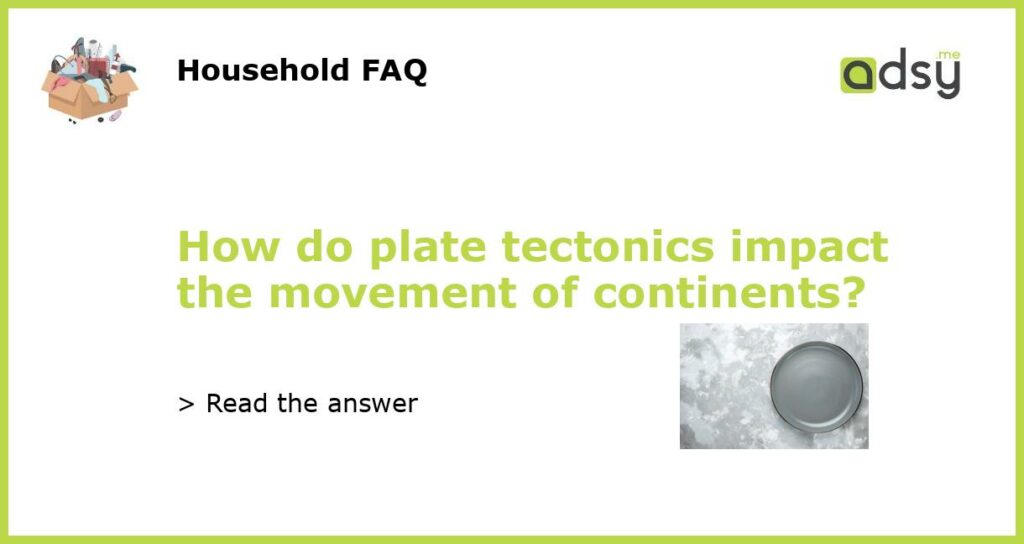Plate Tectonics: A Key Player in Continent Movement
Plate tectonics is a scientific theory that explains the movement of Earth’s rigid lithospheric plates and how they interact with each other. These plates, which make up the outer layer of the Earth’s surface, float on the semi-fluid asthenosphere beneath them. The theory of plate tectonics is crucial in understanding how the continents move across the Earth’s surface.
The Basics of Plate Tectonics
Plate tectonics is based on the idea that the Earth’s lithosphere is divided into several large and small plates. These plates are constantly moving, either away from each other, toward each other, or sliding past one another. The movement is driven by convection currents in the mantle, which is the layer below the Earth’s crust.
The Earth’s lithosphere is broken up into seven major plates, including the North American Plate, South American Plate, Eurasian Plate, African Plate, Australian Plate, Antarctic Plate, and Pacific Plate. In addition to these major plates, there are also several smaller plates that are constantly shifting and interacting with each other.
Impact of Plate Tectonics on Continent Movement
Plate tectonics have a profound impact on the movement of continents. This movement occurs primarily through three main mechanisms: divergent boundaries, convergent boundaries, and transform boundaries.
Divergent Boundaries
Divergent boundaries occur when two lithospheric plates move away from each other. This movement creates a gap between the plates, which is then filled with molten rock from the underlying mantle. As this molten rock cools and solidifies, it forms new crust, which pushes the existing plates further apart. This process is known as seafloor spreading and is responsible for the continuous widening of the ocean basins.
Over time, the movement of divergent boundaries can lead to the formation of new crust and the separation of continents. A prime example of this is the Mid-Atlantic Ridge, where the North American Plate and the Eurasian Plate are moving away from each other. This process has resulted in the formation of the Atlantic Ocean and the separation of North America and Europe.
Convergent Boundaries
Convergent boundaries occur when two lithospheric plates move towards each other. This movement often leads to the collision and subduction of one plate beneath another. When this occurs, the subducting plate is forced into the mantle, where it eventually melts. The melting of the subducting plate creates magma, which rises to the surface and erupts as volcanoes.
The collision and subduction of plates at convergent boundaries can result in the formation of mountain ranges, such as the Andes in South America or the Himalayas in Asia. It can also lead to the merging of continents. For example, the collision between the Indian Plate and the Eurasian Plate has resulted in the formation of the Tibetan Plateau and the Himalayan Mountains, as well as the ongoing convergence of these two plates.
Transform Boundaries
Transform boundaries occur when two lithospheric plates slide past each other horizontally. This movement can occur in different directions, either in the same direction or in opposite directions. Transform boundaries are characterized by the formation of faults, which are fractures in the Earth’s crust where the plates slide past each other.
Transform boundaries do not directly impact the movement of continents. However, they can have significant impacts on the crustal rocks and geological features along the boundaries. For example, the San Andreas Fault in California is a transform boundary where the North American Plate and the Pacific Plate are sliding past each other. The movement along this fault has resulted in numerous earthquakes and the formation of the famous San Andreas Fault system.
Plate tectonics play a crucial role in the movement of continents. Through the processes of divergent boundaries, convergent boundaries, and transform boundaries, the Earth’s lithospheric plates continuously shift and interact with each other. This movement leads to the separation of continents, the formation of volcanoes and mountain ranges, as well as significant geological features and phenomena. By understanding plate tectonics, scientists can gain valuable insights into the Earth’s past and predict future geological events.






